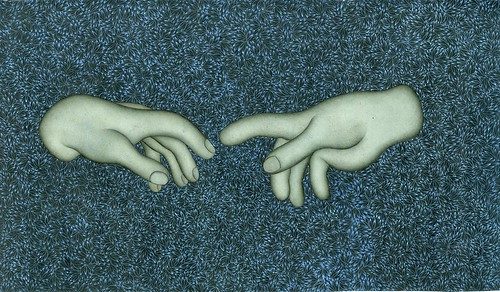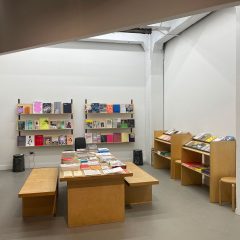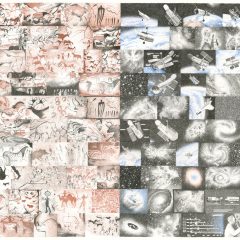This week’s Weekly has my review of Alex Gorlizki’s and Kate Moran’s exhibits at Gallery Joe. Below is the copy with some pictures.

Alexander Gorlizki
Rest in Motion, 2008
AG – 3402
Opaque water colour on paper
8.5 x 10.75 inches
Alex Gorlizki, a sculptor by training, has worked with fabricators of all stripes. His new collaborative works on paper at Gallery Joe demonstrate the London-born New York artist is a new kind of radical transglobal collaborationist. His works made with Indian miniaturists in Jaipur, India, begin with a drawing or idea and end with that idea fleshed out with miniaturist patterning and backgrounds in fine rich colors and gold leaf.
The 20 small works at Gallery Joe are right out of the Warhol factory production line of art-making. Their Third World/First World collaboration may cause you to feel a little uncomfortable (is he paying those Indian miniaturists a fair wage?) but there’s no denying the work is beautiful, dignified and loopy as all get out. The delicate one-hair-brush virtuoso patterning will astonish Philadelphia viewers, whereas the works’ 21st-century pop conceptual underpinnings (some of the work is abstract and cartoonish) would leave an 18th-century raja familiar with miniaturist ways scratching his head.

Alexander Gorlizki
The Exiles, 2008
AG – 3380
Opaque water colour and gold on bookprint
6.75 x 4.75 inches
Several of the most elaborately decorated works are on book plates of film stills (Casablanca, North by Northwest). And what’s been left undecorated in the scene—the nose, eyes, mouth (and in the case of the Casablanca piece, the hats)—stick out as if they were butterflies that landed just so amid all the filagree decor.

All the works—with their rampant patterning and restricted shapes floating in voids of space—have a Chicago Imagist feel. The Exiles in particular reminds me of Ed Paschke’s figure paintings from the 1970s, in which facial features look patched in from outer space. Light Touch shows two hands floating in a leafy blue space reaching out to almost touch their fingers. The work takes Michelangelo’s heroic gesture of God reaching out and creating man and unmoors it from its Western underpinnings. The resulting cartoonlike rendering could be any two people’s delicate hands reaching out—like the artist and the Indian miniaturists, say.

Alexander Gorlizki – Reclining Venus, 2008
AG – 3444
Opaque water colour on paper
10.25 x 7.5 inches
Gorlizki’s works could only have come about since the advent of cheap travel and widely available Internet and phone service. But the artist has been fascinated with Indian miniatures for a long time, having gone to India as a boy with his mother. This is his debut in Philadelphia.

Kate Moran. Suffolk #1 2006. painted wood
Reaching out in another fashion in the gallery’s Vault space is Kate Moran with works that play with subliminal feelings that attach to everyday objects.
Moran’s Suffolk #1, a wood carving of a hand and arm painted black, fingers outstretched, takes its name from Suffolk sheep with their black faces and limbs. The childlike appendage is sweet like a lamb and a reminder of “black sheep” that come in every family. Spindle, another carved piece that looks like a miniature Brancusi Endless Column, plays with the multiple meanings of the utilitarian tool used for spinning wool, or in other contexts, for skewering or turning something in a mechanism.

Kate Moran
spindle, 2006 (detail)
Carved cherry
53 x .74 x .75 inches
Moran, a Pew fellow and widely lauded local artist, continues to reach for psychological depths in works like these and with her new letterpress pieces that scramble sentences and stutter simple words on a page in an attempt to visually capture how her deaf daughter, Sophia, learns language.

Kate Moran
who gave that to me., 2008
Edition of 15: Ed. no. 1 of 15
Signed on verso (no edition number indicated)
Letter press on notebook paper, three panels
9.5 x 21 inches
The 2-D works on ruled notebook paper evoke schoolroom learning methods. As the words wiggle across the page their meaning is less important than the context of their making—the process of learning, and the mystery of mind, brain and body.

Kate Moran – Installation in the Vault with Suffolk #1 and Spindle.









